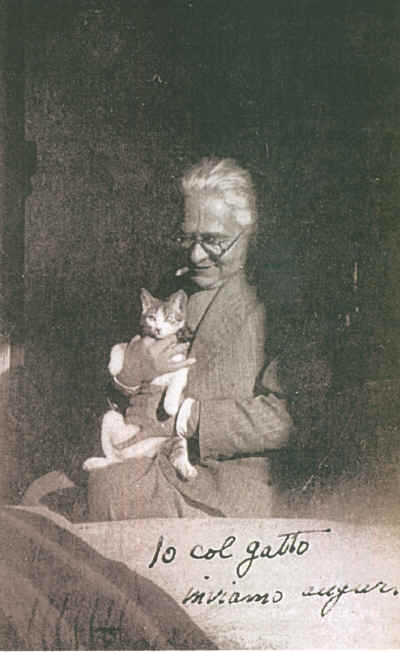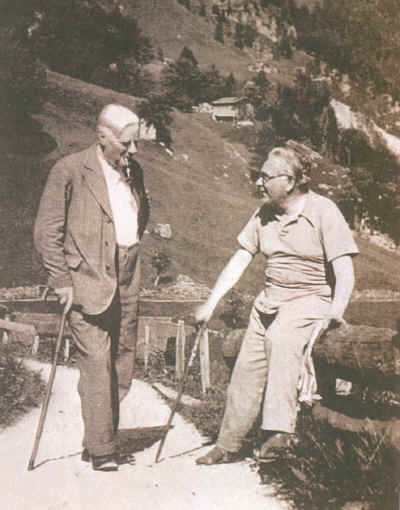

Partner Norman Douglas, Reginald Turner
Queer Places:
24 Museum St, Holborn, London WC1A 1JL, UK
Lungarno delle Grazie 14, Florence
Cemitério do Alto de Sao Joao
Lisbon, Lisboa Municipality, Lisboa, Portugal
 Giuseppe "Pino" Orioli (1884–1942) was a Florentine bookseller
best known for privately publishing the unexpurgated first edition of Lady
Chatterley's Lover and for his long association with Norman
Douglas.[1]
Giuseppe "Pino" Orioli (1884–1942) was a Florentine bookseller
best known for privately publishing the unexpurgated first edition of Lady
Chatterley's Lover and for his long association with Norman
Douglas.[1]
Giuseppe Orioli was born in 1884 in Alfonsine, the son of a shopkeeper who managed a grocery store and a tavern in the Stradone (Corso Garibaldi) in Alfonsine in the province of Ravenna, near the new bridge on the Via Reale, Giuseppe Orioli spent his childhood among the banks of the river Senio, Piazza Monti, the Fosso Vecchio and the Naviglio. He moved to Florence to work in a barber shop when he was 14 years old. After being a soldier at 20, he emigrated to Paris with four dollars in his pocket, and from there he moved on to London. Here he lived of various expedients gradually managing to get to know many characters who will become famous, including D.H. Lawrence, of whom he will become the first editor for the famous erotic novel, which scandalized many: "Lady Chatterlay's lover".[2]
In 1910 the former anarchist Barberi had moved his bookshop to Charing Cross Road and given it a horrible name "The Polyglott Library". Barberi had a partner who could not suffer and implored Orioli to replace him. " I liked the idea - Orioli writes - and when I started my new business I asked him to change the name of the bookstore by calling it" Barberi and Orioli ". In reality it was a closet for library use but it managed to attract the curiosity of many London writers .
Orioli then went to Florence where he opened a book shop with his ex-pupil and friend J. Irving Davis (or John Irving Davis (1889-1967)), in via Vecchietti, financed by the father of his partner. Since then they had fallen in love with the same person, and did not want to quarrel with each other, they decided to return to London in 1913. Here they opened a small shop, at No. 24 on Museum Street, where they sold antique books, also founding a publishing house, which became famous. After the First World War, he returned to Florence, where he opened a shop of his antique books, in Lungarno delle Grazie 14.
Orioli's relationship with Norman Douglas began in Florence after Douglas settled there in 1922. Orioli undertook the private publication of many of Douglas' subsequent writings.[3] They met in June 1922 at the home of such a Miss Wilkins - one of the numerous British ladies, elderly and Puritan, who settled in those years in the Tuscan capital - and from the beginning they were irresistibly attracted to each other, soon formed a solid nucleus around which over the years a growing group of English intellectuals residing in Florence or simply passing through Tuscany gathered. In addition to Lawrence and Aldous Huxley there were Reginald Turner, sir Harold Acton, Richard Aldington, Charles Prentice, W. Somerset Maugham and Compton MacKenzie.

Pino Orioli in 1935, photographed by
Carl Van Vechten

Pino Orioli and Norman Douglas in the Voralberg
D.H. Lawrence had sought to have Lady Chatterley's Lover published conventionally by his publishers in England and the United States, but they were reluctant to undertake its publication because of its explicit sexual content. To circumvent censorship, Norman Douglas urged Lawrence to have the book published privately in Florence, and is believed to have introduced him to Orioli. In March 1928, Orioli and Lawrence took Lawrence's unexpurgated typescript to a Florence printing shop where type was set by hand by Italian workers who did not know any English, resulting in numerous errors in the typesetting. After several delays, including the time required for extensive proofreading by Lawrence, about 1000 copies of the novel were released in July 1928.[4]
In 1929 Orioli founded in Florence a precious publishing house, " The Lungarno Series ", known and admired by bibliophiles of every country. The enterprise lasted until '37, comprising only 12 titles, previously unpublished, by English writers, including some already widely known as DH Lawrence (of which Orioli will publish, in the first edition, Lady Chatterley's Lover ), Douglas himself , W. Somerset Maugham, Richard Aldington. Orioli will also publish his memoirs in English, Adventures of a Bookseller , published in 1944 during the war in Italian by the refined publishing house of Gian Dàuli.
Orioli and Douglas traveled extensively together[2] and were so close that they were known to their friends by the name "Pinorman", a portmanteau word combining Orioli's nickname "Pino" with Douglas' given name of "Norman."[3] Together they wrote Venus in the Kitchen, a collection of aphrodisiac recipes that was published in 1952 under the pseudonym Pilaff Bey.[3] In his book, Pinorman, Richard Aldington writes, ″Pino did know English well and spoke it fluently, though with certain mistakes which gave it a peculiar flavour. And he was perfectly capable of writing those books himself, except that verbal correction would have been needed.″ (The books are apparently Adventures of a Bookseller and Moving Along: Just a Diary.) Aldington then adds that Norman Douglas, rather than make corrections to the two books, ″rewrote Pino's books, and spoiled them, by taking out the special quality which was Pino and substituting his own much less amusing mannerisms.″
The last chapter of Orioli's life is marked by the relationship with Reginald (Reggie) Turner, first-time homosexual wildiano, friends who have moved to Florence in the last years of his life, where he died in December 1938, who had promised to leave the publisher his huge assets (about £ 20,000). Someone claimed that it was this "unhappy dream of wealth" that would have led to the breakup with Douglas who, feeling abandoned and betrayed by his friend, after various mutual misunderstandings ended up, according to someone, to lose his tracks.
In 1939 after the death of Turner, in the middle of the Second World War, Pino Orioli and Carlo Zanotti went to London to try to have the inheritance, but they did not succeed. Surprised by the outbreak of the war, they moved to Lisbon, where they intended to stay two years pending the end of hostilities in neutral Portugal, away from the nightmares of Nazism. After a short time Orioli became seriously ill.
Orioli died on January 2, 1942, at the age of 58, assisted only by his faithful assistant Carletto (Carlo Zanotti), who he named his heir. [2] The history of the split between Douglas and Orioli was denied in 1976 by a work by Mark Holloway who in writing a biography of Norman Douglas (1976) discovered that he was in Lisbon with Orioli when he died. Mark Holloway claims that the story that Douglas let Pino die on his own was invented by Richard Aldington, another mutual friend who hated Douglas.
Always Holloway wrote that the idea that Douglas was not with Pino was one of the most unpleasant things because it was false and denied by Douglas himself in some of his letters. These were written from Lisbon and in them Douglas says he saw Orioli and Carlo every day. They met after lunch, around five in the afternoon in a certain café. All three together went on a trip to Sintra very close to Lisbon, and then also to Coimbra further north. In other letters Douglas describes Pino's state of health, and states that he was there, that he visited him the night before he died and that he then attended the funeral.
He was buried in a niche of the Cemetério Alto de São João enterramento 2214. Carlo Zanotti provided for the funeral. After his death, Orioli inherited the considerable sum left to him by the writer Turner. Carletto Zanotti lived in Lisbon with Orioli's legacy. He never did any work and wasted all his legacy over the years, including the old furniture of the Orioli house (according to when reported by the last remaining relative, Monsignor Giorgio Orioli). He died alone and a widower. Each year he paid the maintenance fee for the tomb at the Lisbon Cemetery until his death in 2003. From 2003 the niche maintenance fee was not paid anymore (65 € per year), so an exhumation took place to transfer the remains to the common ossuary and the old tombstone was destroyed.
My published books: